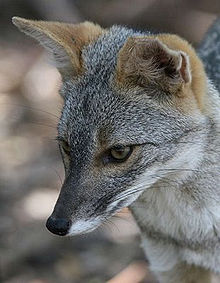Sechuran fox
| Sechuran fox[1] | |
|---|---|

| |
Conservation status
| |
| Scientific classification | |
| Kingdom: | Animalia |
| Phylum: | Chordata |
| Class: | Mammalia |
| Order: | Carnivora |
| Family: | Canidae |
| Genus: | Lycalopex |
| Species: | L. sechurae
|
| Binomial name | |
| Lycalopex sechurae Thomas, 1900
| |

| |
| Sechuran fox range | |
| Synonyms | |
|
Pseudalopex sechurae | |
The Sechuran fox (Lycalopex sechurae), also called the Peruvian desert fox or the Sechuran zorro, is a small South American species of canid closely related to other South American "false" foxes or zorro. It gets its name for being found in the Sechura Desert in northwestern Peru.[1]
Description[]
The Sechuran fox is small for a canid, weighing 2.6 to 4.2 kilograms (5.7 to 9.3 lb), with a head-and-body length of 50 to 78 centimetres (20 to 31 in) and a tail of 27 to 34 centimetres (11 to 13 in). Its fur is gray agouti over most of the body, fading to white or cream coloured on the underparts. There are reddish-brown markings on the backs of the ears, around the eyes, and on the legs. The muzzle is dark grey, and a grey band runs across the chest. Its tail is tipped with black. It has small teeth, adapted to feed on insects and dry plants, with fox-like canine teeth.[3]
The chromosome number is 2n=74.[4]
Distribution and habitat[]
First identified in the Sechura desert, the fox inhabits arid environments in southwestern Ecuador and western Peru, at elevations from sea level to at least 1,000 metres (3,300 ft), and possibly much higher. Within this region it has been reported from the western foothills of the Andes down to the coast, inhabiting deserts, dry forests, and beaches.[5] There are no recognised subspecies.
Several fossils of Sechuran foxes are known from the late Pleistocene of Ecuador and Peru, close to the modern range. Genetic analysis suggests that the closest living relative of the Sechuran fox is Darwin's fox, which is native to Chile.[5]
Behavior and diet[]
The Sechuran fox is nocturnal, and spends the daylight hours in a den dug into the ground. It is generally solitary, although occasionally seen travelling in pairs. Pups are born in October and November, although little else is known of its reproductive behavior.[6]
The fox is an opportunistic feeder, and its diet varies widely depending on the season and local habitat. It has been found to feed on seed pods, especially those of the shrub Prosopis juliflora and of caper bushes, as well as the fruit of Cordia and mito plants, and is capable of surviving on an entirely herbivorous diet when necessary. More commonly, however, it also eats insects, rodents, bird eggs, and carrion as a part of its diet.[7] It can probably survive for long periods of time without drinking, subsisting on the water in its food.[3] Sechuran fox can disperse as many plant species as other more specialized dispensers, such as phyllostomid bat and white-tailed deer.[8]
s been particularly extensive in Ecuador. They have been known to prey on local livestock, such as chickens, and are hunted both to reduce such attacks and so that their body parts can be used in local handicrafts, folk medicine, or magical rituals.[5]
| Wikispecies has information related to Lycalopex sechurae. |
The animal is considered at Low Risk in Ecuador, and hunting is not permitted in Peru without a licence. The species is listed as Near Threatened by the IUCN.[5]
References[]
- ^ a b Wozencraft, W. C. (2005). "Order Carnivora". In Wilson, D. E.; Reeder, D. M. (eds.). Mammal Species of the World: A Taxonomic and Geographic Reference (3rd ed.). Johns Hopkins University Press. ISBN 978-0-8018-8221-0. OCLC 62265494.
- ^ Cossios, D. (2017). "Lycalopex sechurae". IUCN Red List of Threatened Species. 2017: e.T6925A86074993. doi:10.2305/IUCN.UK.2017-2.RLTS.T6925A86074993.en. Retrieved 12 November 2021.
- ^ a b Asa, C. & Cossios, E.D. Canids: Foxes, Wolves, Jackals and Dogs. Status Survey and Conservation Action Plan (PDF). International Union for Conservation of Nature and Natural Resources/Species Survival Commission Canid Specialist Group. pp. 69–72. Archived from the original (PDF) on 1 July 2013.
- ^ Wayne, R. K.; Geffen, E.; Girman, D. J.; Koepfli, K. P.; Lau, L. M.; Marshall, C. R. (1997). "Molecular Systematics of the Canidae". Systematic Biology. 46 (4): 622–53. doi:10.1093/sysbio/46.4.622. PMID 11975336.
- ^ a b c d Cossios, E.D. (2010). "Lycalopex sechurae (Carnivora: Canidae)". Mammalian Species. 42 (1): 1–6. doi:10.1644/848.1.
- ^ Birdseye, C. (1956). "Observations on a domesticated Peruvian desert fox, Dusicyon". Journal of Mammalogy. 37 (2): 284–287. doi:10.2307/1376706. JSTOR 1376706.
- ^ Asa, C. & Wallace, M.P. (1990). "Diet and activity pattern of the Sechuran desert fox (Dusicyon sechurae)". Journal of Mammalogy. 71 (1): 69–72. doi:10.2307/1381318. JSTOR 1381318.
- ^ Escribano-Avila, Gema (24 March 2021). "Non-specialized frugivores as key seed dispersers in dry disturbed environments: An example with a generalist neotropical mesocarnivore". Science Direct. Retrieved 24 March 2021.
- IUCN Red List near threatened species
- South American foxes
- Mammals of Ecuador
- Mammals of Peru
- Near threatened animals
- Near threatened biota of South America
- Mammals described in 1900
- Taxa named by Oldfield Thomas
